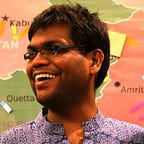Graphic state of mind
(An edited version of this piece was first published in The Hindu Business Line.)
Comics were a large part of my life as a child who felt out of place on the playground but they are only just beginning to enrich my adulthood. The jugalbandi between image and text is soothing in ways that might be difficult to convey to someone who has not tasted its magic yet. In the last couple of weeks while looking for meaning during the COVID-19 pandemic, I must admit that comics have not let me down. They have shown me that the world is indeed topsy-turvy, that laughter can be healing, and that we can care about social justice even in moments of personal fragility.
Sayan Mukherjee (@sayanart on Instagram) is a Kolkata-based illustrator whose comics appeal to me because of their simplicity. Whether it is an image of a man whose wings are being clipped as he is forced into a lockdown, or a father whose son refuses to get off his back during the mandatory work from home situation, or a man struggling to keep his mask in place while balancing heavy bags of groceries in both hands — the artist presents his subjects with an affectionate gaze. He acknowledges their struggle for survival and their desire for freedom.
The use of text in his comics is minimal, and that adds to the impact of his visuals. There is an immediacy to them, an absence of cleverness, and a light-hearted look at what constitutes the new normal. He does not shy away from critique of police brutality, or of citizens who do not follow safety guidelines about physical distancing, but there is a subtlety in his approach that brings the point home without belabouring it.
Ah To, a comic artist living in Hong Kong (@ah_to_hk on Instagram), has a style that is more biting in its satire. My favourite comic is the one that shows toilet paper being preserved in a safe, along with gold bars and surgical masks. However, the comic that has drawn more attention because of its explicitly political stance is one that mocks the World Health Organization’s decision to change the name of the Wuhan coronavirus to novel coronavirus in their attempt to avoid linking the pandemic to China and holding it accountable.
Though it is common knowledge that the Chinese government suppressed crucial information, and endangered many lives all over the world, the economic might of China has led many international leaders to chicken out from naming it as a culprit. The object of ridicule in this comic is WHO Director-General Tedros Adhanom Ghebreyesus, and the one standing up to him is a chicken with a spray can making graffiti on the walls. The images are ingenious and hard-hitting.
While the authoritarian regime in China continues to flex its political muscle, the people who have had to bear the brunt are the citizens and those of Chinese heritage who live in other parts of the world. Unfortunately, the global ire against China has provided fodder for racism against all east Asians who ‘look Chinese’ to people who do not know any better. In India itself, people from the North-east have been subjected to verbal abuse and hate crimes because they are mistakenly viewed as carriers of the virus, therefore a source of danger.
The comics created by Swedish-Korean illustrator, comic book artist and activist Lisa Wool-Rim Sjöblom (@chung.woolrim on Instagram) talk back against sinophobia or chinophobia — terms used to designate discrimination against Chinese people and prejudice against Chinese culture. She lives in New Zealand, and her comics gave a human face to the violence experienced by these racial minorities in predominantly white countries where it has become unsafe for many of them to use public transport.
The most poignant image that has stayed with me is of a mother telling her children, “Because of this virus, there’s a chance that people may say or do mean things to us.” She wants to prepare them for a society that will dehumanize them because of the way they look. While the virus can be tackled with medical treatment and perhaps a vaccine in the future, one wonders if there is any cure for bigotry.
Compassion seems to be the only antidote, as articulated by Mumbai-based cartoonist Hemant Morparia (@hemantmorparia on Instagram) in a recent comic of his wherein a little girl holds her mother’s hand and asks, “You think there will be an outbreak of Karuna (meaning compassion) in Delhi, Ma?” It was published soon after the communal violence in Delhi this February that brought murder and mayhem upon low-income Muslim communities in the capital.
Islamophobic discourse seems to have got a fresh boost with many COVID-19 cases now being traced back to a religious gathering in the Muslim neighbourhood of Nizamuddin in Delhi. While it is important to focus on clusters so that one can contain the spread of the virus, it is unhelpful to demonize a whole community. Anyone who is vigilant enough can see through this ploy to detract from the criticism Prime Minister Narendra Modi has received for his failure to protect the most marginalized at this vulnerable time.
